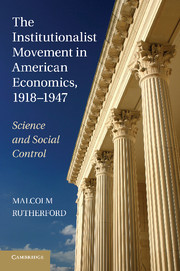Book contents
- Frontmatter
- Contents
- List of Tables
- Acknowledgments
- PART ONE INTRODUCTION
- PART TWO INSTITUTIONALIST CAREERS
- PART THREE CENTERS OF INSTITUTIONAL ECONOMICS
- 5 Institutionalism at Chicago and Beyond
- 6 Amherst and the Brookings Graduate School
- 7 Wisconsin Institutionalism
- 8 Institutional Economics at Columbia University
- 9 The NBER and the Foundations
- PART FOUR CHALLENGES AND CHANGES
- PART FIVE CONCLUSION
- Archive Collections Consulted
- References
- Index
- Titles in the series
7 - Wisconsin Institutionalism
Published online by Cambridge University Press: 03 May 2011
- Frontmatter
- Contents
- List of Tables
- Acknowledgments
- PART ONE INTRODUCTION
- PART TWO INSTITUTIONALIST CAREERS
- PART THREE CENTERS OF INSTITUTIONAL ECONOMICS
- 5 Institutionalism at Chicago and Beyond
- 6 Amherst and the Brookings Graduate School
- 7 Wisconsin Institutionalism
- 8 Institutional Economics at Columbia University
- 9 The NBER and the Foundations
- PART FOUR CHALLENGES AND CHANGES
- PART FIVE CONCLUSION
- Archive Collections Consulted
- References
- Index
- Titles in the series
Summary
During the period between the World Wars, the University of Wisconsin ranked in the top four universities in terms of the numbers of PhD students, well behind Columbia, but close to Chicago and Harvard (Froman 1942; Biddle 1998a). In terms of the production of graduate students of an institutionalist orientation over the whole interwar period, Columbia and Wisconsin dominate the picture. There is no shortage of literature on John R. Commons's career and writings, but there is relatively little written about the nature of Wisconsin economics more generally, or on the careers pursued by the graduate students produced by Commons at Wisconsin (for a partial exception, see Chasse 2004). Commons produced an extremely large number of graduate students, and what became of these students, and the economics they produced in turn, are important questions in understanding the history of institutionalism as a whole. It has been suggested that Wisconsin institutionalism failed to reproduce itself because graduates tended to have careers in government or in non-PhD-granting institutions, and thus had lower “fertility” than graduates from other schools (Biddle 1998a). In the case of Wisconsin, Jeff Biddle's investigation for students graduating between 1920 and 1946 found mixed evidence, but the information contained in Lampman (1993) allows for a more specific approach. Lampman's book identifies those PhD students supervised by Commons and others of institutional persuasion, and also contains some information on the later employment of graduates.
- Type
- Chapter
- Information
- The Institutionalist Movement in American Economics, 1918–1947Science and Social Control, pp. 186 - 222Publisher: Cambridge University PressPrint publication year: 2011

